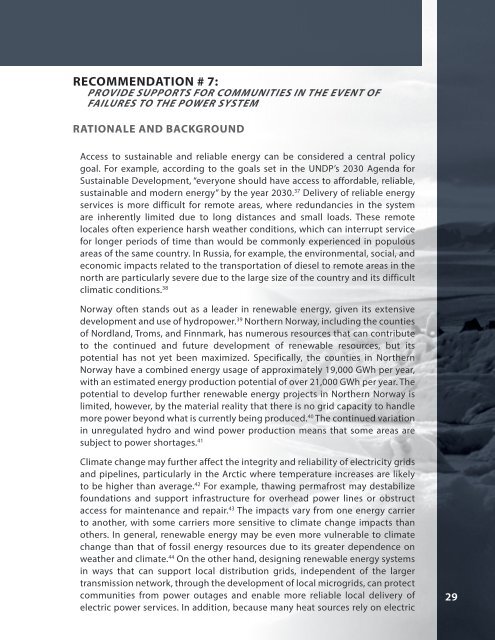DEVELOPING RENEWABLE ENERGY IN ARCTIC AND SUB-ARCTIC REGIONS AND COMMUNITIES
FulbrightArcRenewableEnergy
FulbrightArcRenewableEnergy
Create successful ePaper yourself
Turn your PDF publications into a flip-book with our unique Google optimized e-Paper software.
RECOMMENDATION # 7:<br />
PROVIDE SUPPORTS FOR <strong>COMMUNITIES</strong> <strong>IN</strong> THE EVENT OF<br />
FAILURES TO THE POWER SYSTEM<br />
RATIONALE <strong>AND</strong> BACKGROUND<br />
Access to sustainable and reliable energy can be considered a central policy<br />
goal. For example, according to the goals set in the UNDP’s 2030 Agenda for<br />
Sustainable Development, “everyone should have access to affordable, reliable,<br />
sustainable and modern energy” by the year 2030. 37 Delivery of reliable energy<br />
services is more difficult for remote areas, where redundancies in the system<br />
are inherently limited due to long distances and small loads. These remote<br />
locales often experience harsh weather conditions, which can interrupt service<br />
for longer periods of time than would be commonly experienced in populous<br />
areas of the same country. In Russia, for example, the environmental, social, and<br />
economic impacts related to the transportation of diesel to remote areas in the<br />
north are particularly severe due to the large size of the country and its difficult<br />
climatic conditions. 38<br />
Norway often stands out as a leader in renewable energy, given its extensive<br />
development and use of hydropower. 39 Northern Norway, including the counties<br />
of Nordland, Troms, and Finnmark, has numerous resources that can contribute<br />
to the continued and future development of renewable resources, but its<br />
potential has not yet been maximized. Specifically, the counties in Northern<br />
Norway have a combined energy usage of approximately 19,000 GWh per year,<br />
with an estimated energy production potential of over 21,000 GWh per year. The<br />
potential to develop further renewable energy projects in Northern Norway is<br />
limited, however, by the material reality that there is no grid capacity to handle<br />
more power beyond what is currently being produced. 40 The continued variation<br />
in unregulated hydro and wind power production means that some areas are<br />
subject to power shortages. 41<br />
Climate change may further affect the integrity and reliability of electricity grids<br />
and pipelines, particularly in the Arctic where temperature increases are likely<br />
to be higher than average. 42 For example, thawing permafrost may destabilize<br />
foundations and support infrastructure for overhead power lines or obstruct<br />
access for maintenance and repair. 43 The impacts vary from one energy carrier<br />
to another, with some carriers more sensitive to climate change impacts than<br />
others. In general, renewable energy may be even more vulnerable to climate<br />
change than that of fossil energy resources due to its greater dependence on<br />
weather and climate. 44 On the other hand, designing renewable energy systems<br />
in ways that can support local distribution grids, independent of the larger<br />
transmission network, through the development of local microgrids, can protect<br />
communities from power outages and enable more reliable local delivery of<br />
electric power services. In addition, because many heat sources rely on electric<br />
29


